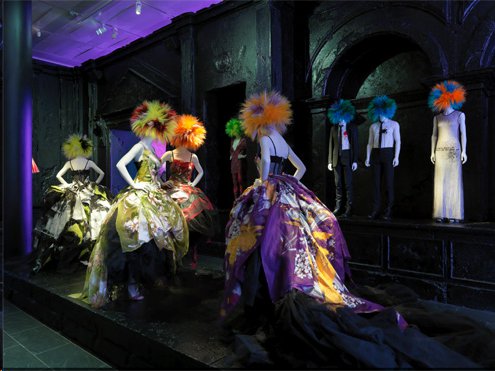Exploring the History of Punk Rock Through Fashion

Mannequins sporting colored wigs and wearing torn shirts, tartan pants, hardware-embellished dresses and trash bags line the walls; accompanying them are sound bites and video clips of Blondie, the Ramones, Sid Vicious and Patti Smith.
This is the set-up for the Metropolitan Museum of Art’s latest Costume Institution exhibit, “PUNK: From Chaos to Couture.”
The exhibition takes a look at, and focuses on, the do-it-yourself aspect of punk fashion and how it influenced high fashion. It’s an interesting relationship to explore: the anti-establishment culture of the punk movement versus the upper echelon of society.

While PUNK has a lot of potential, it fails in trying to set up a historical context throughout the exhibit. It is broken down into seven galleries: New York and London, which defines punk’s origins in said cities; Clothes for Heroes which looks at the McLaren and Westwood shirts from their famed shop SEX/Seditionaries; and the four D.I.Y rooms—Hardware, Bricolage, Graffiti & Agitprop, and Destroy.
A plaque in the beginning of the exhibit reads “While high-fashion’s co-option of punk inevitably sanitizes its anarchic rebelliousness, it also draws attention to its original potency & its singular capacity to engage & excite the imagination.” This holds true in the galleries as you walk through: each D.I.Y room is inspired by four important visual aesthetics of punk fashion. Some of the clothes are beautiful: a black dotted tulle dress by Moschino, embellished with beads and metal; Dolce & Gabbana silk organza graffiti dresses; while others look like copies—the Junya Watanabe mohair sweaters and tartan pants are so strikingly similar to the pieces Vivienne Westwood designed in the 70s.

The history of punk is summarized neatly in the first gallery “New York and London.” It is agreed upon that the punk movement had two separate beginnings and different visuals and sounds, but possessed the same spirit. The key roots of New York’s punk birth was the music; originally the term punk referred to the untrained vocal and instrument sounds of certain bands of the ‘60s, such as the The Sonics. But punk music as it is known today refers to the bands of the late 70s—Blondie, The Ramones, Velvet Underground, The Sex Pistols etc. The music club CBGB OMFUG was also instrumental in popularizing said music scene, and a recreation of the NY club’s bathroom is on display in the PUNK exhibit.
London’s punk music scene gave the world The Clash & The Sex Pistols, British punk is mother to the style and anarchism that is connected with the movement. The founders of punk style are Malcolm McLaren and Vivienne Westwood, who owned the clothing shop SEX in London. Ripped T-shirts, T-shirts with sexually graphic images, tartan-print pants, “bondage” pants and mohair sweaters were all sold in the shop. Other aesthetics associated with punk—spray-painted clothing, clothespins and piercings—were visuals taken from the musicians.

Clothes for Heroes is a mini-showroom dedicated to the clothing that Westwood and McLaren produced in the ‘70s. Mannequins line the wall in their t-shirts, which are silkscreened or printed with curse words and sexual imagery. There are also mannequins side by side displaying clothes from Westwood’s shop and almost exact copies from other designers.
The four galleries are meant to show the punk influences in couture. Starting with Hardware, many dresses are black and white and featured safety pins and chains that hold the dress together or give the illusion of doing so. Perhaps the most recognizable is a Versace dress, with gold oversized safety pins on its side; worn by Elizabeth Hurley in 1994 on the red carpet, its nod to a sexier side of punk. Bricolage features a group of designers who have used items associated with trash—think trash bags, plastic, newsprint—to create clothing. There are trash bag dresses by Gareth Pugh and plastic bodysuits by Maison Martin Margiela. The effect is more ecologically friendly than punk.

Agitprop & Graffiti features designer duds spray-painted or printed with words. There are a few Alexander McQueen and D&G numbers that are intriguing, but the recent Westwood dresses—printed with slogans—speak more to the revolutionary tropes of punk. It is interesting to note that a plaque in the room states how people thought The Clash were mimicking Jackson Pollock when they wore clothes covered in paint, but it happened to be coincidence.
The final room, Destroy, features multiple white T-shirts strategically ripped to pieces by Yohji Yamamoto and Viktor Rolf, as well as Calvin Klein. These displays are juxtaposed by pieces from designer Rei Kawakubo, who experiments with the structure of traditional clothing items to question the traditional standards of beauty. While the designs are strange, these few adorned mannequins might be the only part of the exhibit that captures punk’s essence.
The overall issue with PUNK is the lack of spirit within the exhibit. The designers have adopted the aesthetics and these influences are obvious—but the meaning behind punk, the counter-culture lifestyle and ideology is lost in the translation.
For more information, visit: http://www.metmuseum.org/exhibitions/listings/2013/punk/gallery-views
Author Bio:
Gabriella Tutino is a contributing writer at Highbrow Magazine.




























































































































































































































































































































